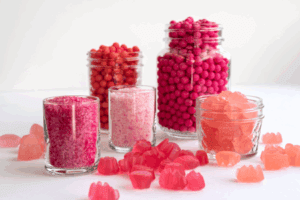International Confectionery Editor Joseph Clarke explores how advancements in wrapping technology are transforming the way confectionery is protected, presented and produced
With visual appeal, product integrity and consumer convenience being paramount, wrapping technology has a vital role to play in the confectionery industry. Far more than a functional afterthought, the way a product is wrapped influences shelf-life, hygiene, brand perception and overall consumer experience. Whether it’s a luxury chocolate bar, a stick of chewing gum, or a bag of individually wrapped sweets, the packaging serves as both a protective layer and a medium for storytelling.
As consumer expectations evolve—demanding sustainability, freshness, portion control and aesthetic sophistication—so too must the systems that deliver these outcomes. Manufacturers are under pressure to maintain high production speeds while accommodating diverse wrapping styles, fluctuating batch sizes and increasingly eco-conscious material choices. This complexity is further amplified by the need for reliable, cost-efficient automation capable of integrating into broader smart factory environments.
Against this backdrop, the world of confectionery wrapping is undergoing a quiet but significant transformation. Machinery providers are refining the precision, versatility and intelligence of their systems to meet both current and emerging demands. In this article, we explore the latest advances in wrapping technology and how leading equipment suppliers—such as ACMA SpA, Lareka Confectionery Equipment B.V., LOESCH Verpackungstechnik GmbH, SACMI Packaging & Chocolate S.p.A., and Theegarten Pactec—are shaping the future of confectionery packaging through innovation, adaptability and sustainable thinking.
Innovation and Automation in Wrapping
In today’s confectionery manufacturing environment, wrapping machines are no longer simple end-of-line solutions—they are critical enablers of production efficiency, quality assurance and brand consistency. The demands placed on wrapping systems have intensified in recent years, driven by the dual pressures of high-speed output and growing product diversity. Whether wrapping filled pralines, chewy sweets or multi-layer bars, confectionery producers require equipment that delivers speed, precision and gentle handling—all within a compact and adaptable footprint.
This has fuelled a wave of technological innovation in the design and engineering of wrapping machinery. One major area of advancement is automation architecture. Contemporary wrapping systems are built to run continuously at high speeds, often exceeding 2,000 units per minute in high-output categories such as hard candies and chewing gum. Theegarten Pactec, for example, has developed machines tailored to such requirements, featuring multi-format compatibility and rapid transition capabilities between wrapping styles such as double twist, bunch wrap and fold wrap. These systems utilise high-speed feeders, automatic splicing units and inline quality control sensors to ensure uninterrupted operation and minimal material waste.
Precision, however, is just as vital as speed—especially for delicate or irregularly shaped products. LOESCH Verpackungstechnik GmbH has made significant strides in improving format flexibility and film handling. Their fold wrapping technologies, often used for chocolate bars and wafers, have been engineered to maintain consistent tension and alignment, even with variable material types. For manufacturers handling seasonal or promotional packaging changes, such precision enables consistent brand presentation while reducing the risk of miswraps or line stoppages.
One of the defining trends in modern wrapping is modular machine design. Modular systems provide producers with a scalable platform that can evolve with their needs, whether they are adding new product formats, integrating smart sensors, or switching to sustainable films. This approach is evident in the portfolio of ACMA SpA, whose machines are designed with open architecture for flexibility in both mechanical and control system components. Their solutions highlight how modularity contributes to reduced downtime, easier maintenance and greater adaptability to changing production demands.
Another technological frontier is digitalisation and intelligent control. Increasingly, wrapping lines are being embedded with sensors and software that allow for real-time data acquisition and analysis. These systems can detect variations in product positioning, monitor wrapping film consumption and provide predictive diagnostics to pre-empt faults. SACMI Packaging & Chocolate S.p.A. has incorporated such features into their equipment, aligning with Industry 4.0 standards and enabling tighter integration with upstream and downstream production systems.
Moreover, advanced wrapping machines are now expected to accommodate a wide spectrum of wrapping materials—ranging from conventional plastics and foils to newer, eco-conscious substrates. This adds a layer of complexity in terms of heat sealing, material feeding and tear-resistance management, which equipment manufacturers are actively addressing through enhanced tension controls, adaptive servo drives and alternative sealing technologies.
The convergence of speed, precision and digital intelligence is transforming wrapping from a discrete process into a strategic hub of production. With machine learning algorithms starting to inform real-time decision-making on the line, the future of wrapping lies in systems that are not only fast and flexible, but also self-optimising. As the confectionery industry becomes more reliant on just-in-time production and custom packaging formats, the role of sophisticated, automated wrapping solutions—developed by companies like Theegarten Pactec, LOESCH, ACMA and SACMI—will become increasingly central to the competitive capabilities of manufacturers worldwide.
Read the full article in our latest issue








